Note from the Web Editor: The following page is not maintained. The information, is included for historical interest only, and should not be relied upon for accuracy for current air quality control procedures or standards.
On Oct. 14, 1947, the Los Angeles County Board of Supervisors established the nation's first air pollution control program by creating the Los Angeles County Air Pollution Control District. This year, 1997, marks the 50th anniversary of an epic war on smog that has been characterized by continual progress.
The following is the complete text of a[n out-of-print] brochure titled "The Southland's War on Smog: 50 Years of Progress on Clean Air" on the early years of Air Pollution Control history in the Los Angeles Metropolitan area.
Contents:
Sidebars:
|
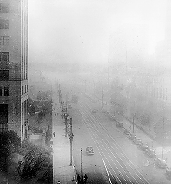
First recorded photo of smog in Los Angeles, 1943
(Photo courtesy of Los Angeles Times Collection, Department of Special Collections, UCLA Library).
|
On July 26, 1943, in the midst of World War II, Los Angeles was attacked -- not by a foreign enemy, but a domestic one -- smog.
TheLos Angeles Timesreported that a pall of smoke and fumes descended on downtown, cutting visibility to three blocks. Striking in the midst of a heat wave, the "gas attack" was nearly unbearable, gripping workers and residents with an eye-stinging, throat-scraping sensation. It also left them with a realization that something had gone terribly wrong in their city, prized for its sunny climate.
The following day, city officials pointed the finger at the Southern California Gas Co.'s. Aliso Street plant, which manufactured butadiene, an ingredient in synthetic rubber. Public pressure temporarily shuttered the plant, but the gas attacks persisted, proving that it was not the prime culprit.
|
|
That summer's "gas attack" was the opening shot in an epic war on smog, which now has been waged for more than half a century. From a ban on backyard trash incinerators to reformulated gasoline, and from inventing the automotive catalytic converter to developing zero-emission fuel-cell electric vehicles, the fight against air pollution has inspired technological innovations and touched off heated political battles. Controlling air pollution has always ignited public controversy.
A look at the past fifty-some years of air pollution control shows how far we've come, and yet how far we still have to go to achieve clean air. It demonstrates that victory over smog can be achieved and that all residents of the Los Angeles Basin can breathe air that meets public health standards.
|

Southern California Gas Co. officials spent $1.5 million in 1946 to eliminate butadiene fumes from their Aliso Street plant by completely enclosing the manufacturing process.
(Photo courtesy of Los Angeles Times Collection, Department of Special Collections, UCLA Library)
|
[Return to Top]
The Arrival of Air Pollution
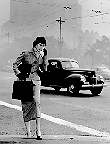
Marion E. Lent dabs at smog-induced tears on her way to work in downtown Los Angeles on Feb. 4, 1953.
(Photo courtesy of Los Angeles Times Collection, Department of Special Collections, UCLA Library)
|
Los Angeles suffered from smog well before World War II. Industrial smoke and fumes were so thick during one day in 1903 that residents mistook it for an eclipse of the sun. From 1905 to 1912, the Los Angeles City Council adopted several measures to combat dense smoke emissions. As the century progressed, the city sprawled and industry boomed, overwhelming those first primitive air pollution control measures.
World War II dramatically increased the region's industrial base and resulting air pollution. The city's population and motor vehicle fleet grew rapidly as well. As a result, according to weather records, visibility declined rapidly from 1939 to 1943.
Angelenos grew increasingly alarmed at the smoke that clouded their vision and the fumes that filled their lungs.
Polluting smoke was so dense and pervasive it constituted a "serious menace" to aviation, according to the county's health officer. Officials at the Monrovia airport reportedly considered moving the airfield to escape the pall.
|
Recognizing the Problem
In October 1943, the Los Angeles County Board of Supervisors appointed a Smoke and Fumes Commission to study the problem. Following their recommendations, supervisors in February 1945 banned emissions of dense smoke and established an office of Director of Air Pollution Control. The City of Los Angeles adopted a similar smoke regulation the same year, but the other 45 cities in the county took little or no action.
During the war, Angelenos perceived smoke from factories as the No. 1 air pollution culprit. In August 1945, the Pasadena Star-News published a series of articles by county Health Officer Dr. H.O. Swartout who asserted that smog, in fact, came from many sources: smoke-belching locomotives and diesel trucks, burning rubbish in back yard incinerators and city dumps and the combustion of scrap lumber in sawmills. Swartout even correctly identified the region's mountain ranges, relatively stagnant winds and atmospheric temperature inversions as major contributors to Southland smog.
In late 1946, the Los Angeles Times hired air pollution expert Raymond R. Tucker of St. Louis to analyze the Los Angeles smog problem and make recommendations to correct it. In a major treatise published in the Times, Tucker reinforced the notion that it was not just a few smokestacks, but a plethora of uncontrolled sources causing the problem:
"Caution should be exercised in placing the entire blame on any one industry, plant or group of individuals," he wrote. "Each contributes its share."
Tucker made 23 specific recommendations, including a prohibition on burning rubbish in backyard incinerators and in dumps, and citing smoking trucks.
He also pointed out that air pollution officials lacked the clout and legislative authority to effectively control smog. In addition, he said, the separate, disjointed efforts of Los Angeles, the county and 45 other cities were ineffective against the regional spread of smog. Tucker recommended creating a powerful county-wide air pollution agency with broad powers to adopt and enforce air pollution regulations.
[Return to Top]
Birth of the First Unified Air Pollution Agency
In 1947, Tucker's recommendations became a reality, in spite of stiff opposition from oil companies and the Chamber of Commerce. These business interests opposed the repeal of a state law giving manufacturers the right to "necessary" discharge of smoke and fumes, and the creation of an air pollution permit system.
On April 15, the county Board of Supervisors approved draft legislation allowing counties to set up unified air pollution control districts. The League of California Cities fully supported the measure, agreeing that air pollution would be more effectively regulated by the county than by individual cities.
The bill sailed through the Legislature on votes of 73-1 in the Assembly and 20-0 in the Senate. Gov. Earl Warren signed the measure into law on June 10. On Oct. 14, 1947, supervisors activated the Los Angeles County Air Pollution Control District, the first in the nation, and appointed Louis C. McCabe as its director. . On Dec. 30, 1947, the district put teeth into its air quality program by requiring all major industries to have air pollution permits.
During the following decade, county supervisors activated air pollution control districts (APCDs) in Orange County in 1950, and in Riverside and San Bernardino counties in 1957. Twenty years later, the four county agencies were combined to form the South Coast Air Quality Management District (AQMD).
[Return to Top]
Unraveling the Mystery of Smog
|
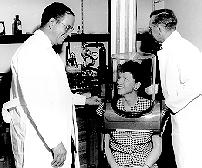
Dr. E.A. Swenson, left, Betty Williams and investigator Herman P. Roth demonstrate apparatus used to test nuisance elements of smog at the University of Southern California's Graduate School.
(Photo courtesy of Los Angeles Times Collection, Department of Special Collections, UCLA Library)
|
As early as 1945, residents referred to the city's pall as "smog," in spite of the fact that the combination of smoke and fog -- which gave rise to the term -- was not very prevalent in Los Angeles. In fact, when the Los Angeles County APCD was created, no one knew exactly what was in smog or what caused it -- nor, therefore, how to control it.
In 1948, Arie J. Haagen-Smit, a chemistry professor at the California Institute of Technology in Pasadena, started examining plants that had been damaged by smog. Farmers near Southland refineries complained that air pollution damaged their crops, bleaching or discoloring the leaves of plants -- something not seen in other parts of the country.
Haagen-Smit, a Dutch flavor chemist who had once developed perfumes, knew that Los Angeles smog was unlike air pollution in eastern U.S. cities, where it was chiefly composed of sulfur dioxides from burning coal and heavy oil.
He also observed that in spite of early smoke control measures, residents still smelled a curious bleaching-solution odor in the air, and suffered severe eye irritation on smoggy days.
|
Margaret Brunelle, a retired chemist who worked with Haagen-Smit for several years, recalls driving through sharply defined, thick banks of smog along the Pasadena Freeway.
"I'd have to pull over by the side of the road because my eyes were tearing so badly I couldn't see to drive," she said.
Haagen-Smit was on the trail of a highly oxidizing element in Los Angeles air. By 1950, his nose and research led him to the culprit: ozone. By exposing plants to ozone in sealed chambers, he showed they suffered similar symptoms as those damaged by smog.
Haaggen-Smit also demonstrated in the early 1950s that ozone caused eye irritation, respiratory problems and damage to materials.
In a Plexiglas chamber set up in the parking lot of the Los Angeles County APCD's Vernon headquarters, researchers created smog by exposing auto exhaust to sunlight. APCD employees voluntarily exposed their eyes to smog from the chamber while workers with stopwatches timed how long it took for tears to stream down the volunteers' faces. S. Smith Griswold, who would later become the district's executive officer, developed bronchitis after voluntarily breathing extremely high levels of ozone in the chamber.
|
After tire manufacturers noticed that rubber deteriorated faster in Los Angeles than other areas of the country, researchers at Cal Tech showed air pollution to be the cause. They found that rubber exposed to high smog levels cracked in just seven minutes. Thus was born one of the early methods for measuring ozone levels -- stretching rubber bands around jars and timing how long the bands took to snap.
Just one question remained: Where did ozone come from? Haagen-Smit and Brunelle drove to Southland refineries and collected samples of air in five-liter flasks. After analyzing the contents and using them to create artificial "Haagen-smog" in the laboratory, Haagen-Smit announced in 1952 that ozone, the primary ingredient in smog, was not directly emitted from tailpipes or smokestacks, but was created in the atmosphere. Driven by sunlight, a photochemical reaction combined hydrocarbons from oil refineries and the partially unburned exhaust of automobiles with nitrogen oxides, a combustion byproduct, to form ozone.
His announcement shocked industrial and civic leaders.
"There was a real uproar about it," Brunelle said.
|
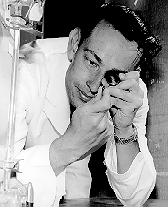
Conrad Vleck of the Los Angeles County Air Pollution Control District examines a rubber strip for the first signs of cracking due to ozone exposure.
(Photo courtesy of Los Angeles Times Collection, Department of Special Collections, UCLA Library)
|
Business leaders argued that irritating ozone came not from oil refineries and cars, but from the stratosphere, where ozone descended to the surface of the Pacific Ocean, then was blown over the Los Angeles area by offshore breezes. Haagen-Smit knew that the atmospheric temperature inversion that trapped smog close to the Earth's surface would form a barrier preventing ozone from descending from the stratosphere. Finally, in 1954, the Stanford Research Institute, funded by oil companies, showed only low levels of ozone on Catalina Island, disproving the migrating ozone theory.
[Return to Top]
Early Smog Control Efforts
In the late 1940s and early 1950s, air pollution officials made significant strides in reducing smoke and fumes by regulating open burning in garbage dumps, reducing smoke from factories and cutting sulfur dioxide emissions from oil refineries.
These measures reduced the "dustfall" by two-thirds, or 1,200 tons per square mile annually, to 1940 levels before smog was a serious problem.
In addition, banning backyard incinerators brought the smog war to the home front and the campaign against smoky orchard "smudge pots" eliminated a highly visible source of pollution.
In 1947, more than 300,000 backyard trash incinerators puffed out white plumes -- and black soot -- across the city.
"People would complain -- especially women hanging up their washing outside -- that the ashes and soot from the incinerators would soil their freshly laundered clothing before it got dry," Brunelle said.
Many residents fiercely opposed plans to ban backyard incinerators, believing that oil refineries were the true cause of smog, and that refineries should be regulated first. More than a decade after the problem was first identified, trash collection programs were established and backyard incinerators were finally banned in 1958.
In the late 1940s, Southland citrus growers operated more than 1 million smudge pots, burning used motor oil, old tires or other wastes to prevent frost damage to crops.
On a cold winter's day, when atmospheric inversions trapped pollutants low to the ground, carbon-black smoke smudged the horizon in places such as Orange County.
"You'd blow your nose, and it would be black," said Edward Camarena, who started his 37-year air pollution control career as a chemist with the Orange County Air Pollution Control District. "There was a belief that smoke helped hold the heat in, and therefore, smoke was good."
The Orange County APCD adopted California's first measure regulating orchard heaters and took on the tough task of convincing growers that the heaters would work just fine, and still prevent frost, if they burned cleaner fuels without smoke.
[Return to Top]
The Birth of Modern Pollution Control
|

Vast clouds of smoke boil into the sky from the Glendale city dump in October 1946. Burning garbage in dumps was a common practice then.
(Photo courtesy of Los Angeles Times Collection, Department of Special Collections, UCLA Library).
|
In London in December 1952, a killer smog so thick that residents could see no more than three feet claimed 4,000 lives. Fearing a similar catastrophe in Los Angeles, Gov. Goodwin J. Knight appointed Arnold O. Beckman of Beckman Instruments to chair a committee recommending air pollution reforms.
One year later, the Beckman Committee made several far-reaching recommendations that set the air pollution agenda for years to come. The committee recommended that:
-
Hydrocarbon emissions be reduced by cutting vapor leaks from refineries and fueling operations;
-
Automobile exhaust standards be established;
-
Diesel trucks and buses burn propane instead of diesel;
-
Heavily polluting industries consider slowing their growth;
-
Open burning of trash be banned; and
-
A rapid transit system be developed.
|
Scientists and the public were beginning to realize that massive amounts of gasoline were evaporating from refinery storage tanks and fuel pump nozzles at service stations throughout the region. The oil industry estimated that 120,000 gallons of gasoline were evaporating daily. County officials believed the loss to be twice as much. Gasoline vapors contain hydrocarbons, a pollutant proven to form ozone.
In 1953, the Los Angeles APCD started requiring controls to reduce hydrocarbon emissions from industrial gasoline storage tanks, thereby reducing 460 tons of smog-forming emissions per day. Subsequent rules reduced hydrocarbon emissions from filling gasoline tank trucks and underground storage tanks at service stations. It wasn't until 1978 that air quality officials required cumbersome sleeves on gasoline fuel pump nozzles to keep hydrocarbon gases from escaping when motorists filled up at service stations.
"That was the most cost-effective thing we've ever done," said Jeb Stuart, executive officer of the South Coast Air Quality Management District when the agency adopted the measure.
It was also one of the most controversial.
"The initial vapor recovery hoses were extraordinarily clumsy," Camarena said. Rumors circulated that vapor recovery "boots" could cause pressure to build up in gas tanks, possibly rupturing them, causing a fuel leak and fire hazard. A bill was introduced in the Legislature to kill the program, but it survived and became, in Camarena's words, "the first control system in the hands of the public."
Today, gas station fuel nozzles are easy to use and must be certified to capture 95% of fumes that would otherwise be released to the atmosphere. Some stations now have "bootless" nozzles that capture vapors with vacuum tubes inside the nozzles.
During the 1950s and 1960s, Southern California air quality officials tackled myriad pollution sources: petroleum-based solvents containing hydrocarbons, landfills emitting toxic gases, power plants emitting nitrogen oxides, even rendering plants that processed animal wastes. Air quality regulations significantly reduced emissions, but peak ozone levels remained extremely high -- more than four times the current health standard. Regulators knew they needed to go after the prime source -- the motor vehicle.
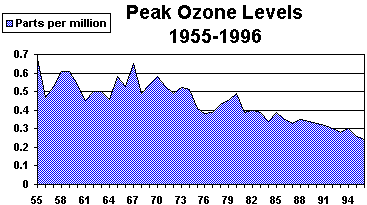
In 1955, when modern ozone monitoring began, Southland residents suffered the highest ozone level ever recorded -- 0.68 parts per million in downtown Los Angeles -- nearly three times the highest level in 1996.
[Return to Top]
Cleaning Up Cars
As Los Angeles became more urbanized, residents needed more wheels. By the late 1950s, experts acknowledged that the rapidly increasing number of vehicles -- fueled by a lack of public transit, long distances between communities, a widespread freeway network and a relatively prosperous economy -- was a major cause of the smog problem.
|
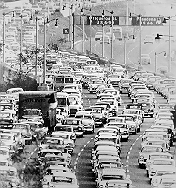
A burgeoning number of cars in the Southland helped create the highest smog levels ever recorded in the 1950s.
Photo courtesy of California Air Resources Board.
|
In 1959, recognizing that counties could not adequately regulate motor vehicle pollution, the Legislature created the California Motor Vehicle Pollution Control Board, and gave it authority to test emissions and certify emission control devices.
Regulators focused first on reducing unburned hydrocarbon emissions from engine crankcases, the source of one-third of total vehicular emissions, according to Arie J. Haagen-Smit, a Cal Tech professor who discovered the composition of smog.
The board required that starting with the 1963 model year, new cars be equipped with a device that routed crankcase "blowby" gases to the manifold, where they were re-burned, rather than venting them to the atmosphere.
The technology worked, but a requirement to retrofit crankcase devices on 1950-1963 model year cars did not fare as well. When widespread -- and unfounded -- rumors charged that the retrofit devices caused engine damage, the Legislature temporarily rescinded the retrofit program and later re-adopted it only for the state's smoggiest areas.
|
Diesel vehicles weren't subject to the same requirement, but smoking trucks were cited by uniformed Los Angeles County APCD officers driving black-and-white patrol cars.
In the late 1960s, California imposed initial regulations reducing cars' tailpipe emissions. The most significant pollution control device -- the catalytic converter -- was not required until the 1975 model year.
"Clearly, catalysts were the top measure," said Stuart, executive officer of AQMD from 1976 to 1986. "Without that, we'd still be choking all over the place."
Although catalysts were proposed and tested in the early 1960s, auto manufacturers strongly resisted their introduction, according to air pollution officials.
"In the beginning, they said it could not be done," said Jim Boyd, executive officer of the California Air Resources Board from 1981 to 1996. "They said the technology was impossible. That it was incredibly expensive."
The catalytic converter requirement was one of the state's first "technology-forcing" regulations, compelling industry to develop a new pollution control capability by a set deadline.
|
"Air quality has improved because of government regulation pushing a reluctant industry to comply with each issue," said Gladys Meade, one of the region's most prominent and longtime clean air activists, and a former board member of both CARB and AQMD.
Technology-forcing regulations in the arenas of zero-emission vehicles and zero-polluting paints are major battlegrounds even today in the debate between what is practical and what is necessary to clean up the nation's dirtiest air.
During the late 1970s, the City of Los Angeles and later the state required vehicle inspections to ensure that pollution control equipment was operating properly and hadn't been tampered. This controversial inspection and maintenance law evolved into today's SmogCheck program, administered by the state Bureau of Automotive Repair. Although the program has achieved some success, environmentalists and the federal government have criticized it for not being effective enough, and controversy still surrounds the debate over how to improve it.
|

UCLA engineers Richard D. Kopa (left) and Hiroshi Kimura inspect a 1960 device that cut nitrogen oxide tailpipe emissions by 50%.
(Photo courtesy of Los Angeles Times Collection, Department of Special Collections, UCLA Library)
|
Cleaning Up Fuels
In the 1960s, regulators took the first step in cleaning up motor vehicle fuels by reducing the amount of highly photochemically reactive olefins in gasoline.
Starting in 1970, the federal government also phased out the use of lead in gasoline, a toxic pollutant that in high levels can cause behavioral problems, learning disabilities and even brain damage in children. Due to the phaseout, lead levels in the Southland have not exceeded state or federal health standards since 1982.
During the 1970s and 1980s, California environmental agencies advocated the use of methanol and natural gas instead of gasoline, which could cut a vehicle's smog-forming emissions in half. "Flex-fuel" vehicles could burn any combination of gasoline and methanol, so drivers never had to worry about availability of fuel.
Although methanol never became a dominant alternate fuel -- in part because its price has remained somewhat higher than gasoline -- the threat of an alternative fuel mandate motivated oil companies to significantly clean up gasoline.
|
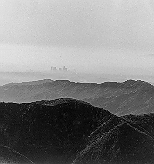
In spite of dramatic reductions from both auto and industry emissions, the metropolitan Los Angeles area still has the worst air quality in the nation.
Photo courtesy of California Air Resources Board.
|
"The oil industry for the first time felt threatened," Boyd said.
In the early 1980s, ARCO introduced the first reformulated gasoline with fewer smog-forming and toxic ingredients. The California Air Resources Board and the U.S. Environmental Protection Agency have since required all oil companies to develop and sell even cleaner gasoline.
Targeting the Total Package: Clean Fuels and Vehicles
In 1990, CARB adopted a landmark regulation targeting both vehicles and the fuels used in them. The agency launched its Low Emission/Zero Emission Vehicle program, requiring auto manufacturers to develop incrementally cleaner cars, culminating with the mandate for an electric, zero-emission vehicle by 1998. CARB officials subsequently delayed the mandate until 2003 after oil and auto manufacturers argued that introducing electric vehicles too soon, before the technology was perfected, could alienate consumers.
|
[Return to Top]
Formation of the South Coast Air Quality Management District
In the early 1970s, residents and air quality officials in San Bernardino and Riverside counties became discontent with the air pollution control efforts of their neighbors to the west in Los Angeles and Orange counties.
Smog respects no political boundaries. Then, as today, most air pollution originated from vehicles and businesses in Los Angeles and Orange counties. The region's westerly sea breezes blow most of that pollution into San Bernardino and Riverside counties each afternoon, leaving residents of the inland valleys to suffer the brunt of smog's effects. Although most studies indicated that smog drifted inland from the west, Los Angeles county officials maintained they had no responsibility to clean up pollution in San Bernardino and Riverside counties, Camarena said.
The regional conflict spurred the Los Angeles County League of Women Voters, led by Gladys Meade, to call for a regional air pollution control agency that encompassed all four counties in the Los Angeles basin. It took more than five years of political battles to make the idea a reality.
In 1975, air quality officials in the four counties formed a short-lived, voluntary regional agency called the Southern California Air Pollution Control District. The agency's fatal flaw was that any county could withdraw at any time, sabotaging a regional control effort.
The Legislature twice passed bills to create a mandatory regional agency, and former Gov. Ronald Reagan vetoed them both. Finally, former Gov. Jerry Brown, making good on a campaign promise, signed Assembly Bill 250 on July 2, 1976, creating the South Coast Air Quality Management District. The law and the AQMD became effective on Jan. 1, 1977.
After developing a consistent set of regulations for the four-county area, AQMD adopted several significant emission-reductions measures, including rules to control man-made dust and reduce nitrogen oxides from power plants by 90%.
[Return to Top]
Envisioning the End of Smog
In 1986, James M. Lents, former director of clean air efforts for the State of Colorado, took the helm at AQMD.
In spite of progress in cleaning the air, businesses and even air quality regulators at the time generally believed it was impossible to achieve air quality standards in Los Angeles. The problem was too severe, the cost of cleanup prohibitive and the technology needed was nowhere in sight, they said.
Lents proposed a bold and revolutionary goal: to develop a strategy that would actually clean up the nation's worst air pollution. Even some of his own staff were skeptical.
Lents directed the development of the agency's first Air Quality Management Plan to lay out a step-by-step blueprint identifying the specific control measures needed to attain clean air standards by 2007. AQMD's Governing Board adopted it in 1989, creating headlines across the nation and in Europe. Achieving clean air would take years of work and major technological breakthroughs, but it was no longer a vague pipe dream.
"One of the unique things the agency has done is create the vision that we can have clean air," Lents said. "The concept of, 'It's impossible to meet current standards' has gone away."
The plan was the first to call for a number of advanced technologies, including zero-emission electric vehicles, and to specify that clean air could not be achieved in the Southland without them.
AQMD's clean air plan put pressure on other agencies to adopt regulations to require development of the new technology needed to achieve clean air standards, Lents said.
One example of regulation fostered by AQMD's plan was CARB's landmark Low-Emission/Zero-Emission Vehicle mandate, which has achieved the development and commercialization of alternate-fueled and electric vehicles.
[Return to Top]
Toxic Air Pollutants
Until the 1980s, conventional wisdom and federal law directed air quality officials to focus primarily on controlling six pollutants: ozone, suspended particles, carbon monoxide, nitrogen dioxide, sulfur dioxide and lead. In 1987, the state Legislature required major emitters of toxic pollutants to assess and make public the health risk of their emissions. The program has been judged a success since dozens of companies have voluntarily reduced their toxic emissions below the threshold to avoid the public relations embarrassment of conducting such a meeting.
AQMD also adopted measures in the late 1980s to control specific toxic pollutants, such as hexavalent chromium and asbestos, as well as chlorofluorocarbons known to destroy the Earth's stratospheric ozone layer.
[Return to Top]
Beyond the Smokestack and Tailpipe
Seeking new areas for pollution reductions -- and cheaper ways to accomplish it -- air quality officials in the late 1980s and early 1990s moved beyond traditional factory smokestack and vehicle tailpipe controls to transportation and market incentive programs.
AQMD's Governing Board adopted a landmark rideshare program in 1987. It required employers with more than 100 employees to offer tangible incentives to employees to carpool and ride public transit to work. For eight years, the program achieved marked success, reducing 272,000 trips per day. But businesses chafed at trying to change employee behavior. They also perceived the program's cost, estimated at $110 per employee per year, as excessive and its administration as overly burdensome.
AQMD refocused the program's emphasis in 1995 from carpooling to a broader goal of reducing vehicle emissions. An extensive menu of options was offered under the rule. In 1996, the Legislature required AQMD to phase out its mandatory program, if voluntary ridesharing shows equivalent emission reductions.
The severe economic recession of the early 1990s spotlighted the need to find the most cost-effective measures possible to reduce emissions. During that time, the San Francisco-based California Council for Environmental and Economic Balance met with AQMD officials and discussed the use of market incentive measures to allow greater flexibility and lower cost in air pollution control.
In response, AQMD in 1993 adopted RECLAIM, the REgional CLean Air Incentives Market. The program includes about 330 of the largest emitters of nitrogen oxides and sulfur oxides, combustion byproducts that form ozone and particulate pollution.
Rather than regulating each polluting piece of equipment and specifying the exact kind of pollution control technology required, RECLAIM imposes an overall emissions limit on each facility. The limit declines each year, so that by 2003, the facilities in sum will have reduced 77 tons of nitrogen oxide emissions and 16 tons of sulfur oxides per day. The business is free to reduce emissions any way it wishes, giving it the flexibility to choose the most cost-effective method.
If a facility reduces its emissions below its limit in a given year, it earns RECLAIM trading credits that can be sold to a facility unable or unwilling to make the changes necessary to meet its target that year. As of early 1997, more than $30 million in RECLAIM credits had been sold, and the program's emission reduction targets were being met.
ARCO, originally opposed to RECLAIM, is now taking advantage of the program's flexibility by building a plastics plant that will both reduce their emissions and increase their profits. The plant, to be built at ARCO's Carson refinery, will recover propylene from crude oil to make polypropylene, a material used in a wide range of consumer plastics including carpeting, upholstery, clothing and twine. During the recovery process, ARCO will remove sulfur and other polluting byproducts that are now burned, thereby reducing sulfur and nitrogen oxide emissions by several hundred tons a year.
AQMD is expanding its market incentive programs to include area-wide pollution sources, such as home hot water heaters. The agency also is developing a broader trading program that will further enhance the efficiency and cost-effectiveness of emissions trading.
[Return to Top]
Fostering Advanced Technologies
Finishing the job of cleaning up Southland smog will require major advances in technology. In 1988, AQMD established its Technology Advancement Office to help private industry speed up the development of low- and zero-emission technologies. Major developments include:
-
Fuel cells -- First developed for use in space, fuel cells now are being used to power buildings, buses and passenger vehicles. Fuel cells produce electricity using hydrogen and air, emitting only water, heat and carbon dioxide. AQMD is supporting their development.
-
Electric vehicles -- AQMD has played a supporting role in the evolution of electric vehicles (EVs) by contributing to research on clean battery recycling, electric vehicle range extenders and a prototype affordable, four-passenger EV.
-
Reformulation of barbecue starter products -- When AQMD adopted a regulation in 1990 requiring manufacturers of barbecue products to slash the smog-forming ingredients in briquettes and starter fluid, skeptics said it would spell the end of backyard barbecuing. Instead, manufacturers found a way to reformulate their products to meet the new standard in less than 15 months.
-
Zero-VOC paints and solvents -- Recently adopted regulations will require manufacturers to further develop zero-polluting solvents and flat paints.
-
Remote sensing -- Research sponsored by AQMD has shown that the use of remote sensing to identify and repair high-emitting vehicles is a cost-effective way of reducing vehicle emissions. Remote sensing uses an infrared beam to instantaneously gauge the level of tailpipe emissions from a passing vehicle.
-
Alternative fuel heavy-duty vehicles and locomotives -- AQMD has helped sponsor several projects demonstrating the use of clean fuels, such as compressed natural gas in heavy-duty trucks and transit buses. AQMD also is contributing to research to develop a liquid natural gas-powered locomotive. Diesel locomotives in the region are responsible for more than 31 tons per day of nitrogen oxide emissions.
[Return to Top]
Growth, the Never-Ending Challenge
Since the dawn of the war on smog, growth has threatened to sabotage every advance in air quality. It is not enough for a car or consumer product to be cleaner tomorrow than it is today. It must be clean enough to account for the fact that more people will be using more vehicles and more products.

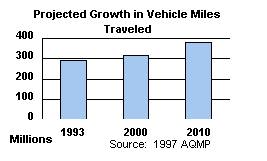
[Return to Top]
After 50 Years, How Close Are We to the Goal?
Clean air is within sight. Stage 1 ozone episodes have plummeted from 121 in 1977 to just seven in 1996, and are projected to vanish entirely by 1999. If all emission reduction measures in the 1997 Air Quality Management Plan are carried out, current federal air quality standards can be met by 2010.
However, studies have shown adverse health effects at levels below current standards. EPA is considering strengthening the ozone standard and adding a new standard for particulate matter smaller than 2.5 microns. Such new standards would require additional emission reductions, particularly from manmade combustion sources.
Achieving the proposed air quality standards in the future will require at least as strong a commitment as residents and officials made in the 1940s, when they first decided to do something about a terrible menace called smog.
[Return to Top]